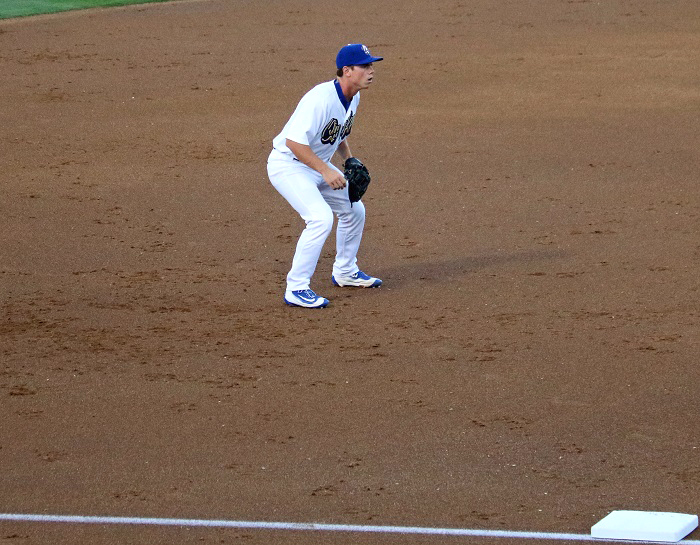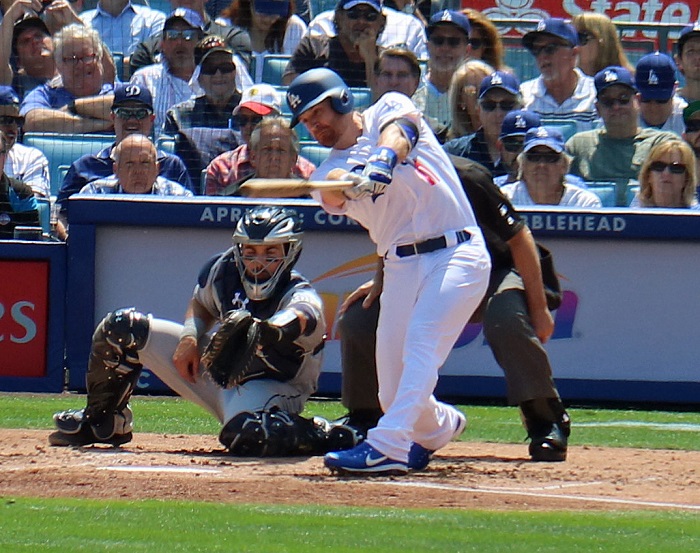On Saturday, April 21, the Rancho Cucamonga Quakes – the Dodgers Advanced Single-A affiliate – took on the Inland Empire 66ers (Angels). The game was an offensive display from Quakes in which they put up seven total runs, three of them by way of the long ball. Aside from the power showcase, Quakes manager Drew Saylor did something for the first time this season and it may have proven what is viewed as invaluable to a young player’s development by the Dodgers front office.
Saylor, for the first time, put 22-year-old catching prospect and 2016 first-round draft pick Will Smith at second base. While this may seem like a mundane or insignificant move to anyone reading this article, I can assure you that it holds far greater importance than you may think of right off the bat (pun intended). This small lineup move speaks volumes about the organization’s willingness to do whatever it takes to increase a young player’s chances of making it to the major leagues. That small thing is versatility.

Even though the Dodgers selected Will Smith as a catcher in the first-round of the 2016 draft, he has already seen time at third base and second base for the Rancho Cucamonga Quakes this season.
(Photo credit – Ron Cervenka)
Versatility, by definition, is the ability to adapt or be adapted to many different functions or activities. In other words, being versatile means that someone or something is capable of accomplishing different tasks in different ways. On the diamond, this small but mighty word is the one used to describe a player that most people would call a “utility player.” And for the Dodgers, being a “utility player” may hold even higher value than playing well at only one position.
Dodger fans see versatility on a daily basis when players like Kiké Hernandez, Austin Barnes, Scott Van Slyke, and Chris Taylor take the field. All of these guys have the ability to play more than one position, and while I hate to say it, not all of them play all of them well.
Last year, the Dodgers kept Hernandez in the majors even though he struggled. As a matter of fact, if you were to ask just about any Dodger fan, aside from his likable personality, they would rather have had just about anyone else in his roster spot because he simply could not hit. But just as often as the strikeouts and empty plate appearances came for Hernandez, so too did the constant reminder that he was there to stay solely because of his ability to play just about every defensive position on the baseball field aside from pitcher and catcher. So Kiké was kept up in the majors solely for his ability just to play different defensive position or, in the words of Drew Saylor, “…allow the team to create different lineups.”
But that was last year. This year, player versatility is magnified even more so and is being used on an even larger scale than last season. This year, the Dodgers’ roster is comprised of players who can play all over the field. Guys like Chris Taylor, Kiké, Chase Utley, Franklin Gutierrez, Austin Barnes and Logan Forsythe (among others) are all on the roster because they, too, can play and fill different roles. This flexibility is the primary factor in the number of different lineups that Dodgers manager Dave Roberts has been able to put out this season. Roberts has been able to utilize different players at different positions based solely on pitching match-ups, regardless of how well or how poorly that given player is hitting the ball at the time.
While what I am saying may come off as a bad thing, it really is not. Versatility is not only a key for the Dodgers in their ability to create a different lineup every day, but it is also extremely valuable on the trade market. Dodger fans were able to see this firsthand this past off-season when the team acquired Logan Forsythe from the Rays in exchange for highly coveted pitching prospect Jose De Leon. Forsythe is capable of playing just about every position, although some more proficiently then others. In his seven-year MLB career, Logan has played at least one inning at every position except center field, catcher and pitcher. This is without a doubt a huge factor in why he was acquired, as it is no secret that the Dodgers will more than likely have to deal with a crazy number of injuries during the long season, and having backups upon backups is not only a luxury but also a necessity.

Since being signed by the Dodgers this past off-season to be their everyday second baseman, seven-year MLB veteran Logan Forsythe has already played three games at third base. The 30-year-old Memphis, Tennessee native also has major league experience at every position except center field, catcher and pitcher. (Photo credit – Ron Cervenka)
So, the main point that is being made here is this: The Dodgers are in a new era of lineup creation and player development. They are not looking to land lock players at a single position anymore, in fact, they are doing quite the opposite. Today the team seems to want to create an environment where players are able to be platooned and used in different locations on the field and for that very reason they are training their top prospects to be able to do just that. It would not surprise me in the least to see players like Will Smith learning the ropes at three or four different positions so that he may be called up at any time and not have his defensive capability hold back his hot bat.
In the end, though versatility appears to be the key to success for the Dodgers, it also appears that it is becoming a trend in the MLB in general.




 April 25th, 2017 at 6:00 am
April 25th, 2017 at 6:00 am  by Jacob Rudner
by Jacob Rudner  Posted in
Posted in 

As an old-school guy, I am not a big fan of utility (bench) players. I certainly get that guys need an occasional break – especially if they are slumping – but I have long favored having the same eight out there for (nearly) every game.
But what absolutely frosts my flakes is Friedman and Zaidi not allowing left-handed hitters to face left-handed pitching. What F&Z and most analytic geeks apparently fail to realize it that the L-on-L numbers are seriously skewed because of the extremely low number of plate appearances their lefty hitters have against left-handed pitching.
In one game last week the Dodgers managed only six hits against a left-hander, but four of those six were by left-handed hitters. How the hell are left-handed hitters going to improve their numbers against lefties if they aren’t given an opportunity to do so?
Man, I miss the good ol’ days of baseball.
You’ve got that right. I’ve long argued that teams create their own problems by platooning young players. If they never bat against a LHP they never learn to hit against a LHP.
At one point last year Andrew Toles led the team in BA against both LHP and RHP (a small sample size against RHP, even smaller against LHP). Then they quit letting him bat against LHP.
It’s all about repetition. I’m sure others have noticed that most switch hitters hit better left handed. They bat left handed more often.
1962: Maury Wills(ss), Jim Gilliam(3b), Willie Davis(cf), Tommy Davis(lf), Ron Fairly(1b) Frank Howard(rf), (last 2 were sometimes switched), Larry Burright(2b), John Roseboro(c), pitcher. I didn’t look up any of that. I’m betting other old timers can do that too. Try doing that with today’s Dodgers.
I’m not really sure about Burright. I do remember that his error at 2b ended Sandy’s chance for his second no-hitter in 3 starts. That also came very close to being the last start of his career.
OK, done showing off. Your points are good. Maybe someday they’ll listen to us geezers.
Probably not.
I agree with your points completely. Regularity in a baseball lineup is essential in order to build up skills against a certain type of pitching. This way does not allow any of the players to develop.
But, at the same time I really do feel as though versatility allows the FO to call up players based on how well they are playing offensively as opposed to limiting their bats due to defense. We just saw this with Bellinger. Top prospect playing tremendous offense in the minors and needs a major league spot to continue the success for the big club. First base is taken and he plays outfield therefor the dodgers can option an outfielder and call him up.
Thank you for reading!
I certainly understand where you are coming from. It is very frustrating when people talk about how the team can’t hit against lefties when that isn’t the real problem. The real issue is there is zero lineup regularity and that is causing players to not get used to hitting regularly. The only person on the roster getting regular at bats is Justin Turner and look how that is turning out. Should be interesting to see where this team can go.
I would disagree with that. Puig is the only player on the team to have started every game and i dont believe that he has been removed from one either. Seager has not started every game but he has played in every single one and has to be right at the top of plate appearances. And its only been a couple that he hasnt started. Turner has sat out. A Gon I believe has come into nearly every game also if not every single one. Grandal has definitely been used as much as a catcher should probably be used without wearing them out.